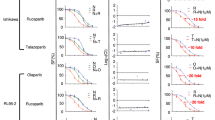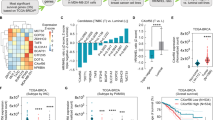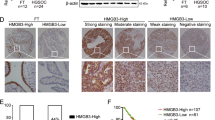Abstract
Inhibitors against poly (ADP-ribose) polymerase (PARP) are promising targeted agents currently used to treat BRCA-mutant ovarian cancer and are in clinical trials for other cancer types, including BRCA-mutant breast cancer. To enhance the clinical response to PARP inhibitors (PARPis), understanding the mechanisms underlying PARPi sensitivity is urgently needed. Here, we show enhancer of zeste homolog 2 (EZH2), an enzyme that catalyzes H3 lysine trimethylation and associates with oncogenic function, contributes to PARPi sensitivity in breast cancer cells. Mechanistically, upon oxidative stress or alkylating DNA damage, PARP1 interacts with and attaches poly-ADP-ribose (PAR) chains to EZH2. PARylation of EZH2 by PARP1 then induces PRC2 complex dissociation and EZH2 downregulation, which in turn reduces EZH2-mediated H3 trimethylation. In contrast, inhibition of PARP by PARPi attenuates alkylating DNA damage-induced EZH2 downregulation, thereby promoting EZH2-mediated gene silencing and cancer stem cell property compared with PARPi-untreated cells. Moreover, the addition of an EZH2 inhibitor sensitizes the BRCA-mutant breast cells to PARPi. Thus, these results may provide a rationale for combining PARP and EZH2 inhibition as a therapeutic strategy for BRCA-mutated breast and ovarian cancers.
This is a preview of subscription content, access via your institution
Access options
Subscribe to this journal
Receive 50 print issues and online access
$259.00 per year
only $5.18 per issue
Buy this article
- Purchase on Springer Link
- Instant access to full article PDF
Prices may be subject to local taxes which are calculated during checkout






Similar content being viewed by others
References
Gibson BA, Kraus WL . New insights into the molecular and cellular functions of poly(ADP-ribose) and PARPs. Nat Rev Mol Cell Biol 2012; 13: 411–424.
Helleday T . The underlying mechanism for the PARP and BRCA synthetic lethality: clearing up the misunderstandings. Mol Oncol 2011; 5: 387–393.
Gudmundsdottir K, Ashworth A . The roles of BRCA1 and BRCA2 and associated proteins in the maintenance of genomic stability. Oncogene 2006; 25: 5864–5874.
Bryant HE, Schultz N, Thomas HD, Parker KM, Flower D, Lopez E et al. Specific killing of BRCA2-deficient tumours with inhibitors of poly(ADP-ribose) polymerase. Nature 2005; 434: 913–917.
Farmer H, McCabe N, Lord CJ, Tutt AN, Johnson DA, Richardson TB et al. Targeting the DNA repair defect in BRCA mutant cells as a therapeutic strategy. Nature 2005; 434: 917–921.
Sonnenblick A, de Azambuja E, Azim HA, Jr, Piccart M . An update on PARP inhibitors–moving to the adjuvant setting. Nat Rev Clin Oncol 2015; 12: 27–41.
Ledermann JA, El-Khouly F . PARP inhibitors in ovarian cancer: clinical evidence for informed treatment decisions. Br J Cancer 2015; 113 (Suppl 1): S10–S16.
Yamaguchi H, Hung MC . Regulation and role of EZH2 in cancer. Cancer Res Treat 2014; 46: 209–222.
Morin RD, Johnson NA, Severson TM, Mungall AJ, An J, Goya R et al. Somatic mutations altering EZH2 (Tyr641) in follicular and diffuse large B-cell lymphomas of germinal-center origin. Nat Genet 2010; 42: 181–185.
Sneeringer CJ, Scott MP, Kuntz KW, Knutson SK, Pollock RM, Richon VM et al. Coordinated activities of wild-type plus mutant EZH2 drive tumor-associated hypertrimethylation of lysine 27 on histone H3 (H3K27) in human B-cell lymphomas. Proc Natl Acad Sci USA 2010; 107: 20980–20985.
Chang CJ, Yang JY, Xia W, Chen CT, Xie X, Chao CH et al. EZH2 promotes expansion of breast tumor initiating cells through activation of RAF1-beta-catenin signaling. Cancer Cell 2011; 19: 86–100.
Li H, Cai Q, Godwin AK, Zhang R . Enhancer of zeste homolog 2 promotes the proliferation and invasion of epithelial ovarian cancer cells. Mol Cancer Res 2010; 8: 1610–1618.
Li X, Gonzalez ME, Toy K, Filzen T, Merajver SD, Kleer CG . Targeted overexpression of EZH2 in the mammary gland disrupts ductal morphogenesis and causes epithelial hyperplasia. Am J Pathol 2009; 175: 1246–1254.
Rao ZY, Cai MY, Yang GF, He LR, Mai SJ, Hua WF et al. EZH2 supports ovarian carcinoma cell invasion and/or metastasis via regulation of TGF-beta1 and is a predictor of outcome in ovarian carcinoma patients. Carcinogenesis 2010; 31: 1576–1583.
Yang CC, LaBaff A, Wei Y, Nie L, Xia W, Huo L et al. Phosphorylation of EZH2 at T416 by CDK2 contributes to the malignancy of triple negative breast cancers. Am J Trans Res 2015; 7: 1009–1020.
Kim KH, Roberts CW . Targeting EZH2 in cancer. Nat Med 2016; 22: 128–134.
Chou DM, Adamson B, Dephoure NE, Tan X, Nottke AC, Hurov KE et al. A chromatin localization screen reveals poly (ADP ribose)-regulated recruitment of the repressive polycomb and NuRD complexes to sites of DNA damage. Proc Natl Acad Sci USA 2010; 107: 18475–18480.
Alekseyenko AA, Gorchakov AA, Kharchenko PV, Kuroda MI . Reciprocal interactions of human C10orf12 and C17orf96 with PRC2 revealed by BioTAP-XL cross-linking and affinity purification. Proc Natl Acad Sci USA 2014; 111: 2488–2493.
Donizy P, Pietrzyk G, Halon A, Kozyra C, Gansukh T, Lage H et al. Nuclear-cytoplasmic PARP-1 expression as an unfavorable prognostic marker in lymph node-negative early breast cancer: 15-year follow-up. Oncol Rep 2014; 31: 1777–1787.
Polotskaia A, Xiao G, Reynoso K, Martin C, Qiu WG, Hendrickson RC et al. Proteome-wide analysis of mutant p53 targets in breast cancer identifies new levels of gain-of-function that influence PARP, PCNA, and MCM4. Proc Natl Acad Sci USA 2015; 112: E1220–E1229.
Roy A, Basak NP, Banerjee S . Notch1 intracellular domain increases cytoplasmic EZH2 levels during early megakaryopoiesis. Cell Death Dis 2012; 3: e380.
Su IH, Dobenecker MW, Dickinson E, Oser M, Basavaraj A, Marqueron R et al. Polycomb group protein ezh2 controls actin polymerization and cell signaling. Cell 2005; 121: 425–436.
Pasini D, Bracken AP, Jensen MR, Lazzerini Denchi E, Helin K . Suz12 is essential for mouse development and for EZH2 histone methyltransferase activity. EMBO J 2004; 23: 4061–4071.
Zhang Y, Wang J, Ding M, Yu Y . Site-specific characterization of the Asp- and Glu-ADP-ribosylated proteome. Nat Methods 2013; 10: 981–984.
Reynolds PA, Sigaroudinia M, Zardo G, Wilson MB, Benton GM, Miller CJ et al. Tumor suppressor p16INK4A regulates polycomb-mediated DNA hypermethylation in human mammary epithelial cells. J Biol Chem 2006; 281: 24790–24802.
Varambally S, Cao Q, Mani RS, Shankar S, Wang X, Ateeq B et al. Genomic loss of microRNA-101 leads to overexpression of histone methyltransferase EZH2 in cancer. Science 2008; 322: 1695–1699.
Ginestier C, Hur MH, Charafe-Jauffret E, Monville F, Dutcher J, Brown M et al. ALDH1 is a marker of normal and malignant human mammary stem cells and a predictor of poor clinical outcome. Cell Stem Cell 2007; 1: 555–567.
Dylla SJ, Beviglia L, Park IK, Chartier C, Raval J, Ngan L et al. Colorectal cancer stem cells are enriched in xenogeneic tumors following chemotherapy. PLoS One 2008; 3: e2428.
Li X, Lewis MT, Huang J, Gutierrez C, Osborne CK, Wu MF et al. Intrinsic resistance of tumorigenic breast cancer cells to chemotherapy. J Natl Cancer Inst 2008; 100: 672–679.
Wang L, Huang X, Zheng XM, Wang XH, Li SW, Zhang L et al. Enrichment of prostate cancer stem-like cells from human prostate cancer cell lines by culture in serum-free medium and chemoradiotherapy. Int J Biol Sci 2013; 9: 472–479.
Wang LH, Liu X, Ren Y, Zhang JY, Chen JL, Zhou WL et al. Cisplatin-enriching cancer stem cells confer multidrug resistance in non-small cell lung cancer via enhancing TRIB1/HDAC activity. Cell Death Dis 2017; 8: e2746.
Martin KA, Cesaroni M, Denny MF, Lupey LN, Tempera I . Global transcriptome analysis reveals that poly(ADP-ribose) polymerase 1 regulates gene expression through EZH2. Mol Cell Biol 2015; 35: 3934–3944.
Mateo J, Carreira S, Sandhu S, Miranda S, Mossop H, Perez-Lopez R et al. DNA-repair defects and olaparib in metastatic prostate cancer. N Engl J Med 2015; 373: 1697–1708.
Murai J, Huang SY, Das BB, Renaud A, Zhang Y, Doroshow JH et al. Trapping of PARP1 and PARP2 by clinical PARP inhibitors. Cancer Res 2012; 72: 5588–5599.
Vilar E, Bartnik CM, Stenzel SL, Raskin L, Ahn J, Moreno V et al. MRE11 deficiency increases sensitivity to poly(ADP-ribose) polymerase inhibition in microsatellite unstable colorectal cancers. Cancer Res 2011; 71: 2632–2642.
Barber LJ, Sandhu S, Chen L, Campbell J, Kozarewa I, Fenwick K et al. Secondary mutations in BRCA2 associated with clinical resistance to a PARP inhibitor. J Pathol 2013; 229: 422–429.
Norquist B, Wurz KA, Pennil CC, Garcia R, Gross J, Sakai W et al. Secondary somatic mutations restoring BRCA1/2 predict chemotherapy resistance in hereditary ovarian carcinomas. J Clin Oncol 2011; 29: 3008–3015.
Jaspers JE, Kersbergen A, Boon U, Sol W, van Deemter L, Zander SA et al. Loss of 53BP1 causes PARP inhibitor resistance in Brca1-mutated mouse mammary tumors. Cancer Discov 2013; 3: 68–81.
Rottenberg S, Jaspers JE, Kersbergen A, van der Burg E, Nygren AO, Zander SA et al. High sensitivity of BRCA1-deficient mammary tumors to the PARP inhibitor AZD2281 alone and in combination with platinum drugs. Proc Natl Acad Sci USA 2008; 105: 17079–17084.
Du Y, Yamaguchi H, Wei Y, Hsu JL, Wang HL, Hsu YH et al. Blocking c-Met-mediated PARP1 phosphorylation enhances anti-tumor effects of PARP inhibitors. Nat Med 2016; 22: 194–201.
Byers LA, Wang J, Nilsson MB, Fujimoto J, Saintigny P, Yordy J et al. Proteomic profiling identifies dysregulated pathways in small cell lung cancer and novel therapeutic targets including PARP1. Cancer Discov 2012; 2: 798–811.
Krishnakumar R, Gamble MJ, Frizzell KM, Berrocal JG, Kininis M, Kraus WL . Reciprocal binding of PARP-1 and histone H1 at promoters specifies transcriptional outcomes. Science 2008; 319: 819–821.
Sala A, La Rocca G, Burgio G, Kotova E, Di Gesu D, Collesano M et al. The nucleosome-remodeling ATPase ISWI is regulated by poly-ADP-ribosylation. PLoS Biol 2008; 6: e252.
Krishnakumar R, Kraus WL . PARP-1 regulates chromatin structure and transcription through a KDM5B-dependent pathway. Mol Cell 2010; 39: 736–749.
Cha TL, Zhou BP, Xia W, Wu Y, Yang CC, Chen CT et al. Akt-mediated phosphorylation of EZH2 suppresses methylation of lysine 27 in histone H3. Science 2005; 310: 306–310.
Chen S, Bohrer LR, Rai AN, Pan Y, Gan L, Zhou X et al. Cyclin-dependent kinases regulate epigenetic gene silencing through phosphorylation of EZH2. Nat Cell Biol 2010; 12: 1108–1114.
Kaneko S, Li G, Son J, Xu CF, Margueron R, Neubert TA et al. Phosphorylation of the PRC2 component Ezh2 is cell cycle-regulated and up-regulates its binding to ncRNA. Genes Dev 2010; 24: 2615–2620.
Li J, Hart RP, Mallimo EM, Swerdel MR, Kusnecov AW, Herrup K . EZH2-mediated H3K27 trimethylation mediates neurodegeneration in ataxia-telangiectasia. Nat Neurosci 2013; 16: 1745–1753.
Palacios D, Mozzetta C, Consalvi S, Caretti G, Saccone V, Proserpio V et al. TNF/p38alpha/polycomb signaling to Pax7 locus in satellite cells links inflammation to the epigenetic control of muscle regeneration. Cell Stem Cell 2010; 7: 455–469.
Sahasrabuddhe AA, Chen X, Chung F, Velusamy T, Lim MS, Elenitoba-Johnson KS . Oncogenic Y641 mutations in EZH2 prevent Jak2/beta-TrCP-mediated degradation. Oncogene 2014; 34: 445–454.
Wei Y, Chen YH, Li LY, Lang J, Yeh SP, Shi B et al. CDK1-dependent phosphorylation of EZH2 suppresses methylation of H3K27 and promotes osteogenic differentiation of human mesenchymal stem cells. Nat Cell Biol 2011; 13: 87–94.
Chu CS, Lo PW, Yeh YH, Hsu PH, Peng SH, Teng YC et al. O-GlcNAcylation regulates EZH2 protein stability and function. Proc Natl Acad Sci USA 2014; 111: 1355–1360.
Yu YL, Chou RH, Shyu WC, Hsieh SC, Wu CS, Chiang SY et al. Smurf2-mediated degradation of EZH2 enhances neuron differentiation and improves functional recovery after ischaemic stroke. EMBO Mol Med 2013; 5: 531–547.
Montgomery ND, Yee D, Chen A, Kalantry S, Chamberlain SJ, Otte AP et al. The murine polycomb group protein Eed is required for global histone H3 lysine-27 methylation. Curr Biol 2005; 15: 942–947.
Levaot N, Voytyuk O, Dimitriou I, Sircoulomb F, Chandrakumar A, Deckert M et al. Loss of Tankyrase-mediated destruction of 3BP2 is the underlying pathogenic mechanism of cherubism. Cell 2011; 147: 1324–1339.
Liu C, Wu J, Paudyal SC, You Z, Yu X . CHFR is important for the first wave of ubiquitination at DNA damage sites. Nucleic Acids Res 2013; 41: 1698–1710.
Wang YT, Yang WB, Chang WC, Hung JJ . Interplay of posttranslational modifications in Sp1 mediates Sp1 stability during cell cycle progression. J Mol Biol 2011; 414: 1–14.
Gonzalez ME, Li X, Toy K, DuPrie M, Ventura AC, Banerjee M et al. Downregulation of EZH2 decreases growth of estrogen receptor-negative invasive breast carcinoma and requires BRCA1. Oncogene 2009; 28: 843–853.
Wang L, Zeng X, Chen S, Ding L, Zhong J, Zhao JC et al. BRCA1 is a negative modulator of the PRC2 complex. EMBO J 2013; 32: 1584–1597.
Li T, Cai J, Ding H, Xu L, Yang Q, Wang Z . EZH2 participates in malignant biological behavior of epithelial ovarian cancer through regulating the expression of BRCA1. Cancer Biol Ther 2014; 15: 271–278.
de Vries NA, Hulsman D, Akhtar W, de Jong J, Miles DC, Blom M et al. Prolonged Ezh2 depletion in glioblastoma causes a robust switch in cell fate resulting in tumor progression. Cell Rep 2015; 10: 383–397.
Campbell S, Ismail IH, Young LC, Poirier GG, Hendzel MJ . Polycomb repressive complex 2 contributes to DNA double-strand break repair. Cell Cycle 2013; 12: 2675–2683.
Edelheit O, Hanukoglu A, Hanukoglu I . Simple and efficient site-directed mutagenesis using two single-primer reactions in parallel to generate mutants for protein structure-function studies. BMC Biotechnol 2009; 9: 61.
DelloRusso C, Welcsh PL, Wang WX, Garcia RL, King MC, Swisher EM . Functional characterization of a novel BRCA1-Null ovarian cancer cell line in response to ionizing radiation. Mol Cancer Res 2007; 5: 35–45.
Elstrodt F, Hollestelle A, Nagel JHA, Gorin M, Wasielewski M, van den Ouweland A et al. BRCA1 mutation analysis of 41 human breast cancer cell lines reveals three new deleterious mutants. Cancer Res 2006; 66: 41–45.
Xu JH, Huo DZ, Chen YH, Nwachukwu C, Collins C, Rowell J et al. CpG island methylation affects accessibility of the proximal BRCA1 promoter to transcription factors. Breast Cancer Res Treat 2010; 120: 593–601.
Acknowledgements
This study was supported in part by the following: the National Institutes of Health (CA211615 and CCSG CA016672); Patel Memorial Breast Cancer Endowment Fund; National Breast Cancer Foundation, Inc.; Breast Cancer Research Foundation; The University of Texas MD Anderson Cancer Center-China Medical University and Hospital Sister Institution Fund; Ministry of Science and Technology; International Research-intensive Centers of Excellence in Taiwan (I-RiCE; MOST 105-2911-I-002-302); Ministry of Health and Welfare, China Medical University Hospital Cancer Research Center of Excellence (MOHW106-TDU-B-212-144003); Center for Biological Pathways; The UT Southwestern Endowed Scholar Program, the Welch Foundation (I-1800) and National Institutes of Health (GM114160) to YY. Dr YY is a Virginia Murchison Linthicum Scholar in Medical Research and a CPRIT Scholar in Cancer Research.
Author information
Authors and Affiliations
Corresponding author
Ethics declarations
Competing interests
The authors declare no conflict of interest.
Additional information
Supplementary Information accompanies this paper on the Oncogene website
Supplementary information
Rights and permissions
About this article
Cite this article
Yamaguchi, H., Du, Y., Nakai, K. et al. EZH2 contributes to the response to PARP inhibitors through its PARP-mediated poly-ADP ribosylation in breast cancer. Oncogene 37, 208–217 (2018). https://doi.org/10.1038/onc.2017.311
Received:
Revised:
Accepted:
Published:
Issue Date:
DOI: https://doi.org/10.1038/onc.2017.311
This article is cited by
-
PARP Inhibitors in Breast Cancer: a Short Communication
Current Oncology Reports (2024)
-
Biomarkers beyond BRCA: promising combinatorial treatment strategies in overcoming resistance to PARP inhibitors
Journal of Biomedical Science (2022)
-
Finding an easy way to harmonize: a review of advances in clinical research and combination strategies of EZH2 inhibitors
Clinical Epigenetics (2021)
-
Going beyond Polycomb: EZH2 functions in prostate cancer
Oncogene (2021)
-
C/EBPβ promotes poly(ADP-ribose) polymerase inhibitor resistance by enhancing homologous recombination repair in high-grade serous ovarian cancer
Oncogene (2021)



